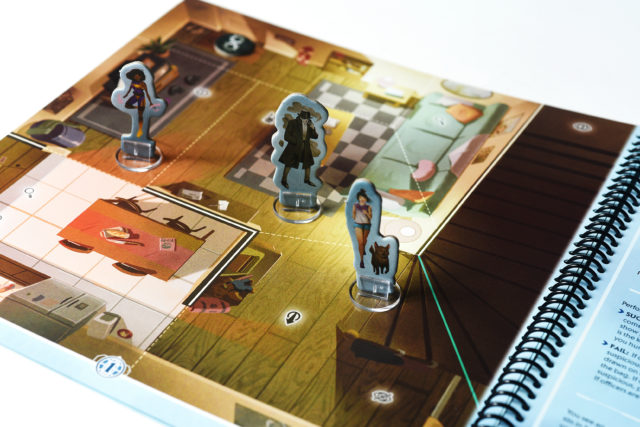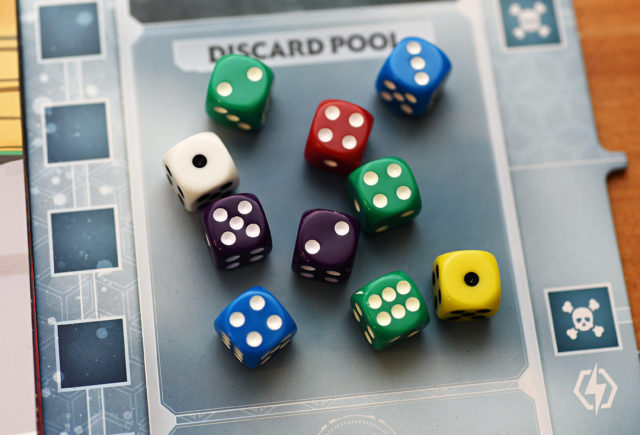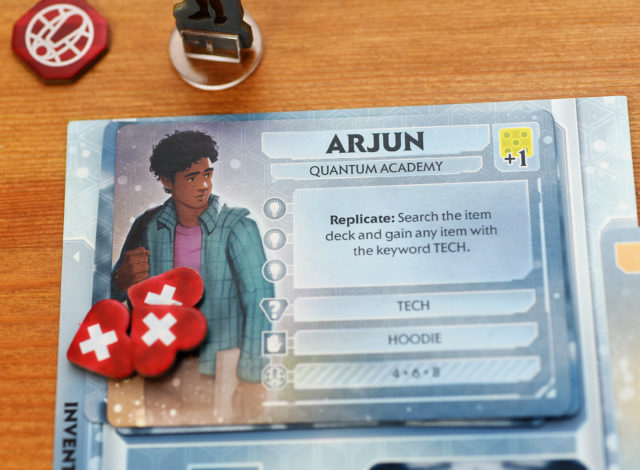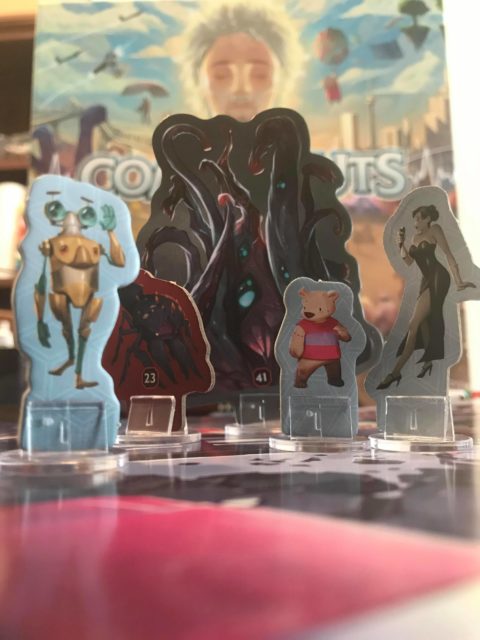I have been ruminating over writing this review for months now. Each time I got through my draft I felt like I needed just one more play of the game to really write about it. Just one more play. One more world. One more try. Comanauts is Plaid Hat’s 2018 Adventure Book game by Jerry Hawthorne about travelling through one man’s subconscious to try to save the world. It is story driven and offers a campaign to play through.

To break down the game, Comanauts is a dice based action selection game with a spine built around this ongoing narrative. It’s an Adventure Book game, so the board is a book, which allows for many maps with custom rules and mechanics and threats and challenges as the game goes on. As you progress, you turn the pages, revealing new maps and new rules. Dr. Martin Strobal is a doctor whose work is pretty life changing for humanity. He invented something called the Mobius Ring, a device that, when it malfunctioned, put Martin into a coma and created a singularity that threatens to destroy humanity. He is the only one who can save us now. Our job, as a ragtag team of consciousness cops is to break into the doctor’s fractured dream state and defeat his biggest, darkest emotions. Regret, Anger, Resentment, Fear, all personified as big scary villains to fight, these I.D. Entities. All of this is done aided by his childhood self and as bizarre avatars who often don’t even belong in the worlds you’re exploring. Want to play as a cute little video game robot? Can do! What about a teddy bear? You better believe it!
The story and the atmosphere of this game is its absolute success. The comazones are diverse and feel like completely different worlds. Since all the stories are driven by emotion, they don’t always have to be logical. One of the comazones, The Dusty Gulch, is a western created by Martin’s mind to hide trauma that he experienced while serving in the Middle East. Star’s Edge is a side scrolling video game world created out of Martin’s memories of his favourite game. Star’s Edge is my favourite map, one that delves into the 2D video game world by taking the standees out of stands and moving them flat across the pages. These cool choices that bring theme and atmosphere to the game really make the gameplay pop. Jerry Hawthorne really succeeds at making the worlds feel different.

Mechanically it is quite simple. Draw dice, use those dice to perform specific actions. Many actions require any die, while many more require specific dice and ask you to roll above a certain threshold. Your main goal is to get from your starting comazone to one of the other comazones in the game, to find and defeat the Prime I.D., the emotion that is haunting Martin in this game. This can mean spending brief periods in certain worlds before deciding you’ve wandered away from the proper emotion and leaving to go to another world.
One of the main effects of this is that you often get a little preview of a world in one game before you delve deeper into that world in another. This mechanic is SO COOL. In a recent game, we played through The Dusty Gulch, a world we wandered in and out of in an earlier game. It gave us an idea of what to expect, how to optimize play, and what to avoid. It is important to not spend too long in a world though, if you think that world isn’t the prime world of that particular game.

In essence, the game is a race. A race against the time to complete the unknown tasks of the world before you lose out to the threats. A race against Martin’s deteriorating state. Certain moments in the game will cause you to draw a vital signs card. There are ten of these cards, and you lose the game when you draw the flatline card, which is always the 8th, 9th, or 10th card in this deck. This vital signs deck tends to be the main time limit for the game. Travelling through a comazone will have you drawing several of these cards, and losing combats will have you drawing more. The effect is a game with a fast countdown that you need to be aware of.
For me, there were two main areas in which Comanauts fell flat. First, the rulebook. The rulebook for this game, not including art and component lists, is six pages long. Six pages. Six pages to make you understand the scope of the game, the mechanics, the travel between worlds, the combat, and how it all comes together. Six pages is plenty for a relatively straightforward game. Comanauts, with all its mechanics and fringe cases, needs more than six pages. Sure, through the Adventure Book there are many more rules taught and explained, but six pages is just absolutely not enough space to effectively communicate what this game is. The game needs an index to easily find what you’re looking for. For a relatively easy game, we found ourselves going back to the rulebook way too much, asking questions about how the rules of the game interacted with the rules of the comazone. The rulebook needs guidance on playing this game as an ongoing campaign. Information about how to play as a campaign is only found upon beating the first game, in the last pages of the Adventure Book. When we lost our first game it just left us wondering “What now?”

The game also suffers from its length. Games tended to be upwards of two and a half hours. Even once we got a rhythm going (and played with 2 players instead of 4), our games were never less than two hours. With the relatively light mechanics, the joy that the game brought felt dragged out over a too long period of time. This can be mitigated by taking breaks at the natural intervals of travelling between comazones, but they still aren’t really natural breaks, given that the journey is still ongoing; you are still investigating the same Prime I.D. and you don’t want to lose your train of thought.

I also just felt like the game was a little too tough. We lost more than half of our games, always due to that flatline card showing up, and it is just an incredibly dissatisfying way to lose a game. In other Co-operative games that I love, like Pandemic or Spirit Island, the game state builds up to a point where you can no longer survive, building up this incredible tension as things get worse and worse. In Comanauts, you flip a card that loses you the game. If this is the eighth card, it just feels bad. If it is tenth, there is some tension building through cards 8 and 9, but it doesn’t really feel like you lost because of your choices. You just lost because you ran out of time.
The story and world-building in Comanauts is second to none. Even the fiction is lovely; it isn’t just good board game fiction – it’s good fiction. If you want to experience an interesting world through board gaming, this is one of the best games to offer that. Learn about who Martin is. Learn about his fears, his regrets, his self-doubt. Find out what shaped this man and how he became who he is today. Then, try to save his life. If you are looking for complex strategizing and a game to delve into and figure out how all the pieces come together, this probably isn’t the title you want.
Comments
No comments yet! Be the first!